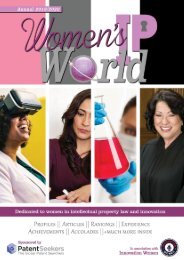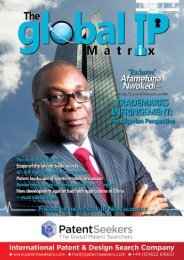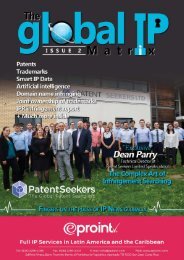Global IP Matrix - Issue 6
HAPPY NEW YEAR 2020 to all our readers. It has been a fantastic year for The Global IP Matrix, and 2020 is shaping up to become an even bigger and productive year for us. We have kept to our promise of giving our readers diverse news from the IP world straight from the frontline and hope you agree! We want to thank all our amazing contributors and give them credit for all the content they have submitted to us over the year. Without their expert knowledge, we would not be where we are today. We endeavor to provide our readers with engaging and up to date topics, written by specialists in the industry at all levels with an unbiased approach. Our ethos is ‘each one teach one', shared knowledge is key. We look forward to continuing to provide the right content to keep you wanting to read more in the coming year. Please enjoy this issue and look out for us again in a few months. From all of us at The Global IP Matrix & Northon’s Media, PR & Marketing
HAPPY NEW YEAR 2020 to all our readers.
It has been a fantastic year for The Global IP Matrix, and 2020 is shaping up to become an even bigger and productive year for us. We have kept to our promise of giving our readers diverse news from the IP world straight from the frontline and hope you agree!
We want to thank all our amazing contributors and give them credit for all the content they have submitted to us over the year. Without their expert knowledge, we would not be where we are today.
We endeavor to provide our readers with engaging and up to date topics, written by specialists in the industry at all levels with an unbiased approach. Our ethos is ‘each one teach one', shared knowledge is key.
We look forward to continuing to provide the right content to keep you wanting to read more in the coming year. Please enjoy this issue and look out for us again in a few months.
From all of us at The Global IP Matrix & Northon’s Media, PR & Marketing
Create successful ePaper yourself
Turn your PDF publications into a flip-book with our unique Google optimized e-Paper software.
China’s Newly Enacted Regulation of
Governing Trademark Applications to
Further Implement How to
Reduce Trademark Squatting
As of November 1, 2019, China’s
amended trademark law has already
come into force. The National People’s
Congress has amended six articles of
the trademark law in which one of
the significant changes is focusing on
reducing trademark squatting and
taking serious measures against bad
faith applications. To fully ensure the
smooth implementation of the revised
Trademark Law against bad faith
applications, the State Administration
for Market Regulation (SAMR) has
passed the regulation of governing
trademark applications, which help
to interpret these new changes in the
revised Trademark Law.
How to define bad
faith and intent to use?
Under Article 4, paragraph 2 of the New
Trademark Law is amended to read
Applications for trademark registrations in
bad faith, which are not intended for use shall
be refused. The Chinese Trademark Office can
now reject applications for bad faith during the
substantive examination before publication. In
addition, Article 33 for oppositions and Article
44 for invalidations now make reference to
amended Article 4, thereby making bad faith a
basis for oppositions and invalidations.
Currently, there are many articles on violation
of the principle of good faith in the trademark
law. As prescribed by the regulations in article
3 of the regulation, in practice, common type
of violation of the principle of good faith are
listed as follows: 1.malicious application no
intent to use; 2. copy, imitation or translation
of other well-known trademarks; 3. former
agents, representatives apply for trademarks
of another party; 4. based on contracts,
business or other relationship, knowing others’
trademark prior to use of trademarks and apply
for registration of the trademarks; 5. Where
the existing prior right of another person is
infringed, or the trademark that another person
has already used and has certain influence
is registered in advance by unfair means; 6.
Where the trademark registration is applied
for by cheating or other unfair means, or other
Written by Mr. Lei Zhao – Senior Partner at Unitalen Attorneys
www.unitalen.com
ACTS that violate the principle of good faith,
social order, and good customs or have other
bad effects are committed. The regulation
made precise requirements for trademark
registrations, provided a more explicit basis
for examination and law enforcement, and
conducted publicity, interpretation, and
positive guidance to the public.
In examination practice, if the CTMO finds
that trademark applicants without any justified
reason, engage in a large number of trademark
applications or registrations, trademark trading
all the time, illegally using public resources,
and frequently file for trademark applications
on the dissimilar goods or services on the
registered trademark of others. Specifically,
TRADEMARKS
when determining whether a malicious
application is constituted, examiners need to
make analysis and judgment based on multiple
considerations and evidence, such as using
the trademark examination system to check
the applicant’s application history, transfer
and other related matters and screening
well-known trademarks, well-known place
names and other prohibited marks. Through
the business license, enterprise information
publicity system to the industry, illegal records,
and so on. Also, according to the provisions
of article 29 of the trademark law, in the
examination process, if the examiner believes
that the applicant is suspected of malicious
application or hoarding registration, he or she
may be required to make relevant explanations.
What kind of
requirements and
penalties will be given
to agencies?
Article 19, paragraph 3 of the New Trademark
Law is amended to read ‘a trademark agency
shall not accept the entrustment of a principal
if it knows or should have known that the
trademark entrusted by the principal for
registration application falls under any of the
circumstances prescribed by Article 4, Article
15 and Article 32 of this Law’.
This implies that a trademark agency must
commit at least a minimum level of due
diligence of client’s proposed marks before
filing and this also indicates that the trademark
agency must firstly refuse the representation
of a bad faith filer if the agency knows or
should have known that the bad faith filer
was squatting. The regulations regulate the
behavior of the trademark agency.
If the above acts are verified, the market
supervision and administration department at
or above the county level will order correction
within a time limit, give a warning and impose
a fine of not less than 10,000 Yuan but not
more than 100,000 Yuan. The place where
the perpetrator is located or where the illegal
act is committed, the person in charge will
be directly responsible and other persons
directly responsible shall be given a warning
and imposed a fine of not less than 5,000
Yuan but not more than 50,000 Yuan. If a
crime is constituted, criminal responsibility
shall be investigated according to law. If
serious, the administrative department
of intellectual property rights may
decide to stop accepting the
trademark agency’s filings of
trademark and make a public
announcement.
In addition, other processing
measures can also be applied,
including 1.the punishment
information into the national
enterprise credit information
publicity system to the public;
2. interview the principal of
the agency for rectification, 3.
the trademark association of
trademark agency shall take selfdiscipline
measures according to law.
What kind of
measures and penalties
are given to those
who file bad faith
applications?
In practice, credit punishment is a very
effective means of regulation for those who
engage in illegal acts. There have been many
successful experiences in the field of patents,
including in November 2018, the National
Development and Reform Commission, the
People’s Bank of China, the State Intellectual
Property Office and other departments jointly
issued “cooperation memorandum of joint
discipline against serious discredit in the field
of intellectual property rights (patents)”, in
which abnormal patent application behavior is
listed as one of the serious discredit acts. To this
end, the CNIPA is studying the formulation
of the “management measures on the list of
objects subject to severe breach of trust in the
field of patents”, which details the operational
issues concerning the implementation of
the memorandum. The measures for the
management of the list of serious breaches of
trust, which is being formulated by the State
Administration for Market Regulation, is
also considering the abnormal application of
patents as one of the cases on the list of serious
breaches of trust. Next, joint punishment
for malicious trademark applications will
be specified in relevant regulations and
documents, following the practice in the
patent field.
Epilogue
In 2018, about 100,000 bad faith trademark
applications were rejected in the examination
and objection process, and 24,000 malicious
applications were rejected in the second quarter
of 2019, accounting for about 4.2% of the total
rejected in the same period. The latest revision
of the trademark law and the promulgation
of this regulation provide a more explicit and
more direct legal basis for cracking down on
malicious application for registration, which
is conducive to further strengthening the
fight against malicious trademark registration.
Next, the Chinese Trademark Office will
formulate specific regulations as soon as
possible to refine the malicious application
without intent to use as stipulated in article 4
of the Trademark Law and publish typical cases
of malicious application for trademarks in
recent years to reflect the legislative effect and
deterrent force. At the same time, the CNIPA
will continue to promote a new round of
preparations for an overhaul of the trademark
law, through the study of the evaluation of
the implementation of the trademark law,
concerned about social hot issues to carry out
special demonstration, widely listen to advice,
strengthen the protection of trademark rights.
We believe that with the
implementation of these
new regulations, the
administrative order of
trademark registration
will be further
standardised to create a
better market competition
environment.
10 www.gipmatrix.com
11
www.gipmatrix.com












